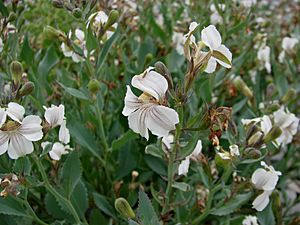White goodenia facts for kids
Quick facts for kids White goodenia |
|
|---|---|
 |
|
| Goodenia albiflora in the Royal Botanic Gardens, Cranbourne | |
| Scientific classification | |
| Genus: |
Goodenia
|
| Species: |
albiflora
|
| Synonyms | |
|
|
The White Goodenia (also known as Goodenia albiflora) is a beautiful flowering plant. It belongs to the Goodeniaceae family. This plant is special because it only grows in South Australia. It's a small, upright bush with ribbed stems. Its leaves are shaped like eggs and grow along the stem. The White Goodenia has white flowers that grow in clusters. Each flower has small, leaf-like parts at its base. After flowering, it produces oval-shaped fruits.
Contents
What Does White Goodenia Look Like?
The White Goodenia is an upright bush. It usually grows up to 70 centimeters (about 2.3 feet) tall. Its stems have ridges, like small bumps or lines. The plant often has a slightly grayish-blue color, which is called glaucous.
Its leaves grow directly on the main stem. They are shaped like an ellipse or an egg. These leaves are about 3 to 7 centimeters (1.2 to 2.8 inches) long. They are also 1.5 to 4 centimeters (0.6 to 1.6 inches) wide. The edges of the leaves can be wavy or have small teeth.
White Goodenia Flowers
The flowers of the White Goodenia grow in long clusters called racemes. These clusters can be up to 10 centimeters (4 inches) long. Each flower sits on a small stalk called a pedicel. This pedicel is about 1 to 2 millimeters long. The whole flower cluster grows on a main stalk called a peduncle, which is 2 to 4 millimeters long.
At the base of each flower, there are small, leaf-like parts. These are called bracteoles and are about 3 millimeters long. The green parts that protect the flower bud are called sepals. They are shaped like a spear and are about 5 to 6 millimeters long.
The main part of the flower, the corolla, is white. It is about 1.5 to 2 centimeters (0.6 to 0.8 inches) long. The inside of the corolla has tiny hairs. The lower parts of the flower petals are about 1 centimeter long. They have small "wings" that are 2.5 to 3 millimeters wide.
White Goodenia usually blooms from October to January. After the flowers, the plant produces oval-shaped fruits. These fruits are called capsules and are about 1 centimeter long.
How Did White Goodenia Get Its Name?
The scientific name for White Goodenia is Goodenia albiflora. A scientist named Diederich Franz Leonhard von Schlechtendal first officially described this plant in 1847. He published his description in a science journal called Linnaea.
The second part of its scientific name, albiflora, is from Latin. It means "white-flowered". This name perfectly describes the plant's beautiful white blooms!
Where Does White Goodenia Grow?
White Goodenia is found only in South Australia. It likes to grow in rocky soil on steep hillsides. You can find it in woodlands. It grows in areas from the Eyre Peninsula to the Flinders Ranges and the Mount Lofty Ranges.

